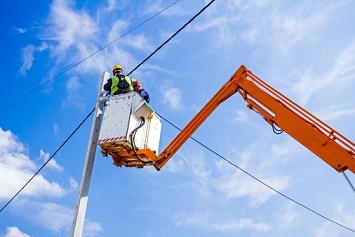With winter weather comes the potential for severe storms—and the aftermath may include the necessity for utility repair work and/or tree removal. Aerial lifts are often employed in these purposes, and one Safety.BLR.com subscriber wanted to know what the fall protection requirements are for this machinery. Read on to see what the experts had to say.
Question: Is it required for operators to be harnessed with a lanyard inside a cherry picker aerial lift?
Answer: Pursuant to 29 CFR 1910.67(c)(2)(v), workers must wear a personal fall arrest or travel restraint system that meets the requirements of 29 CFR 1910 Subpart I and attach it to the boom or basket when working from an aerial lift such as a cherry picker. In a Letter of Interpretation dated March 22, 1976, OSHA clarified that the use of the word “from” does not imply that employees are exempt from wearing fall protection when working on an aerial lift. As stated in the LOI, “A review of both general industry and the construction standards support this interpretation by stating: ‘Employees shall always stand firmly on the floor of the basket and shall not sit or climb on the edge of the basket or use planks, ladders or other devices for a work position.’” Further, in its Scaffolding eTool, OSHA reiterates that while operating an aerial lift, workers must ensure that access gates or openings are closed and:
- Stand firmly on the floor of the bucket or lift platform.
- Not climb on or lean over guardrails or handrails.
- Not use planks, ladders, or other devices as a working position.
- Use a body harness or a restraining belt with a lanyard attached to the boom or bucket.
Additionally, please note that belting off to an adjacent pole, structure, or equipment while working from an aerial lift is not permitted.
Note that body belts may not be used as a personal fall arrest system. They are acceptable as travel restraint systems only.
This question was answered by experts at Safety.BLR.com. If you would like to take a free trial of this valuable safety resource, click here.

